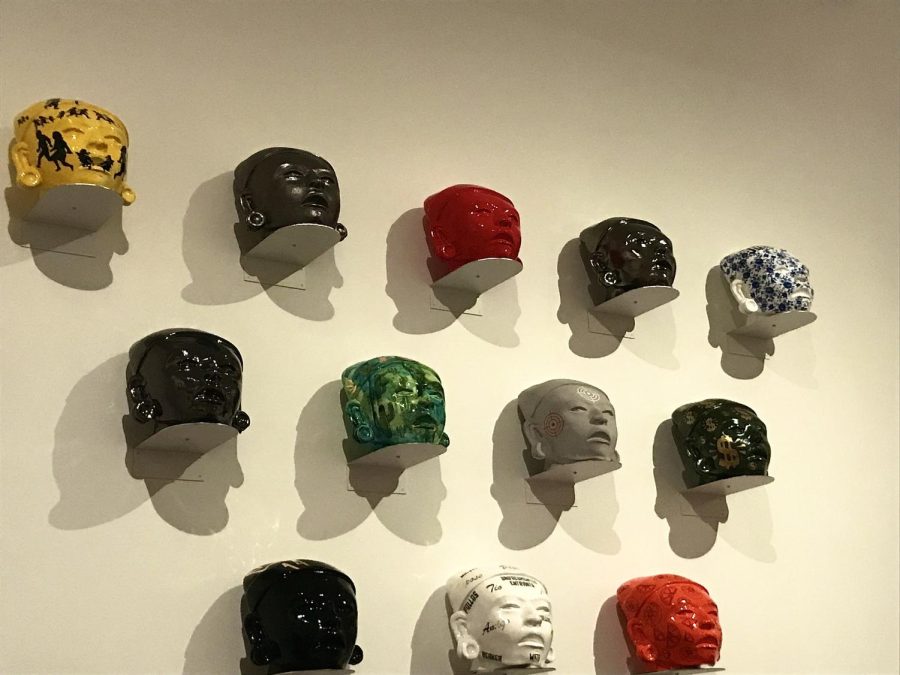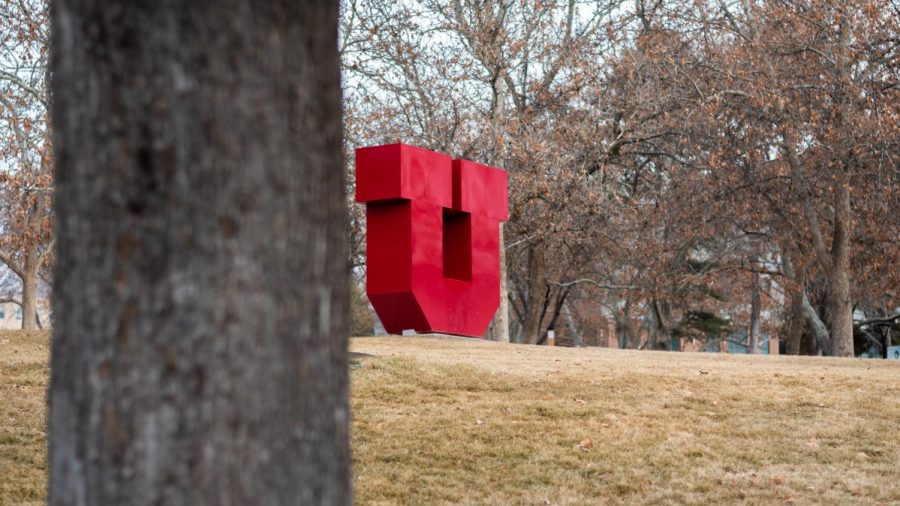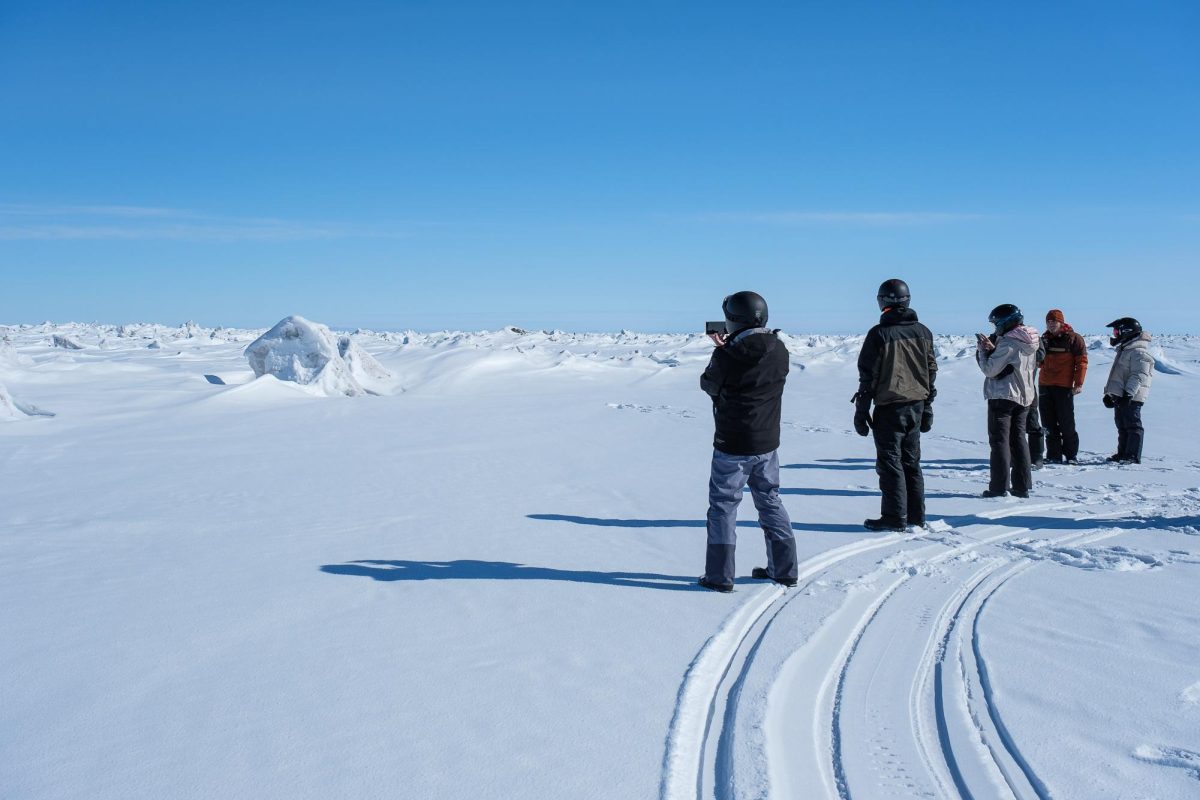Contemporary Traditions in Horacio Rodriguez’s Salt Series Exhibition
Horacio Rodriguez’s “El Camino del Diablo, the Devil’s Highway: The Yuma 14” (2022). (Photo by Avery Greig | The Daily Utah Chronicle)
February 4, 2022
The Utah Museum of Fine Art’s latest salt series installment features artist Horacio Rodriguez, whose work urges viewers to examine the identity of borders and the layered contexts of the ancient and the contemporary.
Salt 15: Horacio Rodriguez
It’s official: Horacio Rodriguez is the UMFA’s fifteenth salt series artist. The series, affectionately named after Salt Lake City, seeks to display the work of emerging artists worldwide, “to reflect the impact of contemporary art, forging connections to the global.”
Rodriguez’s oeuvre explores heritage and personal identity, often by engaging with politics and confronting commercial appropriation. The artist applies layers of external glazes, gold luster, and decals to ceramics of various objects including handguns, a childhood boombox from 1984, and pre-Columbian artifacts from his personal collection. In the past collection Molotov Project, Rodriguez uses a ceramic soda bottle form to create various works in the shape of a molotov cocktail — an instrument of resistance. Rodriguez sees his slip-casts as “blank canvases,” and creates metaphors that expand through generations of historical contexts.
Making Again
“Make America Great Again,” the core mantra of the Trump campaign, is a phrase with which all Americans are familiar. The slogan, along with other phrases and political quotes, takes on a new meaning with the medium of Rodriguez’s works. For the salt:15 exhibition, Rodriguez utilized digital scanning and 3D printing, creating slip-cast replicas of pre-Columbian objects before garnishing them with a contemporary patina.
Rodriguez’s artistic method, as seen in salt:15, interacts with modern contexts through the lens of ancient Mesoamerican art. “I seek to transform and infuse new meaning into objects and symbols synonymous with my pre-Hispanic and Mestizo culture, as well as the seductive visual language of Western dominant culture,” says Rodriguez in his artist statement. “This creates a hybrid work which mimics my own layered identity.”
The exhibition features several artworks that critically examine the taut history of the United States-Mexico border, which Rodriguez has engaged with artistically since his time in graduate school. “El Camino del Diablo, The Devil’s Highway: The Yuma 14″ is a work located on the west wall of the exhibition that features fourteen ceramic heads modeled on “Veracruz Seated Woman,” a statue from the UMFA’s collection. The fourteen heads represent the fourteen lives lost in the deadliest attempt for migrants to cross the U.S. border in Arizona. Rodriguez describes the busts as honoring their spirits, each one meticulously and individually crafted with layers of embellishment.
Convocation of Narratives
A video work featuring a drive-by of the border’s wall sits in the center of the main exhibition, acting as the sun while objects Rodriguez salvaged from the actual border in Arizona orbit in potent silence. The exhibition extends down the UMFA’s Mesoamerican Art Gallery where Rodriguez’s photography of the U.S.-Mexico border coexist with the gallery’s artworks, forming a long hallway layered with historical comparison.
As a viewer, I personally found myself stunned by the binaries created by the exhibition between the Mesoamerican collection and photographs of the border, double-exposures, raw materials next to slip-cast models, and instruments of amplification decaled in lingering phrases.
The UMFA’s fifteenth salt series, curated by Senior Curator Whitney Tassie, engages with contemporary issues through cultural traditions that Rodriguez as a self-proclaimed “future ancestor” poses for generations to come.
Rodriguez’s salt exhibition is on view from Jan. 22 through June 26, 2022.








